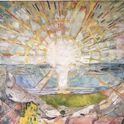There are lots of weird side benefits in having studied classics—even a bit of classics, not necessarily the full torture version involving learning the dual and the aorist passive. One of them is knowing, roughly, what the hell is going on when you look up at an elaborately painted ceiling in some grand country house, or gazing at the walls of the National Gallery.
It has to be said, it doesn’t get you a 100 per cent score—I often think how much better I would be at this if only I could get round to reading the Bible, Ariosto’s Orlando Furioso and a whole bunch of no doubt vastly improving texts that supply subjects for Renaissance and Baroque art. Classics also helps in untangling the references for more recent art, too: Giacometti had obviously submerged himself in the visual world of the Etruscans to create his etiolated bronze figures, and Cy Twombly, who lived in Rome, spent years of his life absorbing classical visual culture, which he refracted into his paintings and sculptures in often indirect ways.
Some of my favourite works in the National Gallery in London have a close relationship with the Roman texts that inspired them. Titian’s earlyish masterpiece, his 1522 Bacchus and Ariadne, shows the moment that the Cretan princess meets the god of wine. Ariadne has woken up to find that she has been abandoned overnight on the shore of Naxos. She’s just been going crazy with anger and incomprehension as she sees the sail of her lover’s ship dwindling on the horizon. But behind her, the god suddenly approaches, accompanied by a gang of drunken Maenads and Satyrs and boozy old Silenus slumping on his donkey. She spins round. Bacchus leaps out of his chariot—that’s the precise second that Titian paints, as the god is mid-air, and their eyes are fixed on each other.
It’s an easy picture to love, with its marvellous zingy blue skies and characters painted across the canvas as if they were figures in an ancient frieze. But it also, satisfyingly for me, has a close relationship with a long poem by Catullus that tells this precise story. The kicker is that the poem tells the story through a description of an elaborately embroidered textile, so Titian, by painting it, reminds us that the poem was describing visual art, and almost returns it to its source.
All this is a long way round of saying that painters can be acute readers of classical poetry, even though we know that Titian didn’t read Latin, and probably worked via translations or paraphrases.
That said, I’m caught out pretty often, and mythological scenes on paintings can be a good prompt to learn new stories. I once had the good fortune to be walking around Chatsworth House with the great collage artist, Linder. She pointed to a dimly lit corner of a bedroom ceiling, and showed me a little scene she’d been puzzling over—it showed humans with frogs’ heads. I suspect I’d already showed off to her about how I knew my myths, but I was stumped.
Actually, it’s a scene in Ovid’s Metamorphoses. The goddess Leto, pregnant with twins, is on the run from Juno, the wife of the babies’ father, Jupiter. She is in Lycia, desperate for water. But some local people have muddied the water of a pond she was about to drink out of. Mean of them—so Leto turns them into frogs. It’s quite a popular subject—Brueghel painted the scene, for example. You’ll know it for next time.

Illustration: Kate Hazell
How studying classics taught me how to appreciate art
Painters can be acute readers of classical poetry
November 11, 2019











